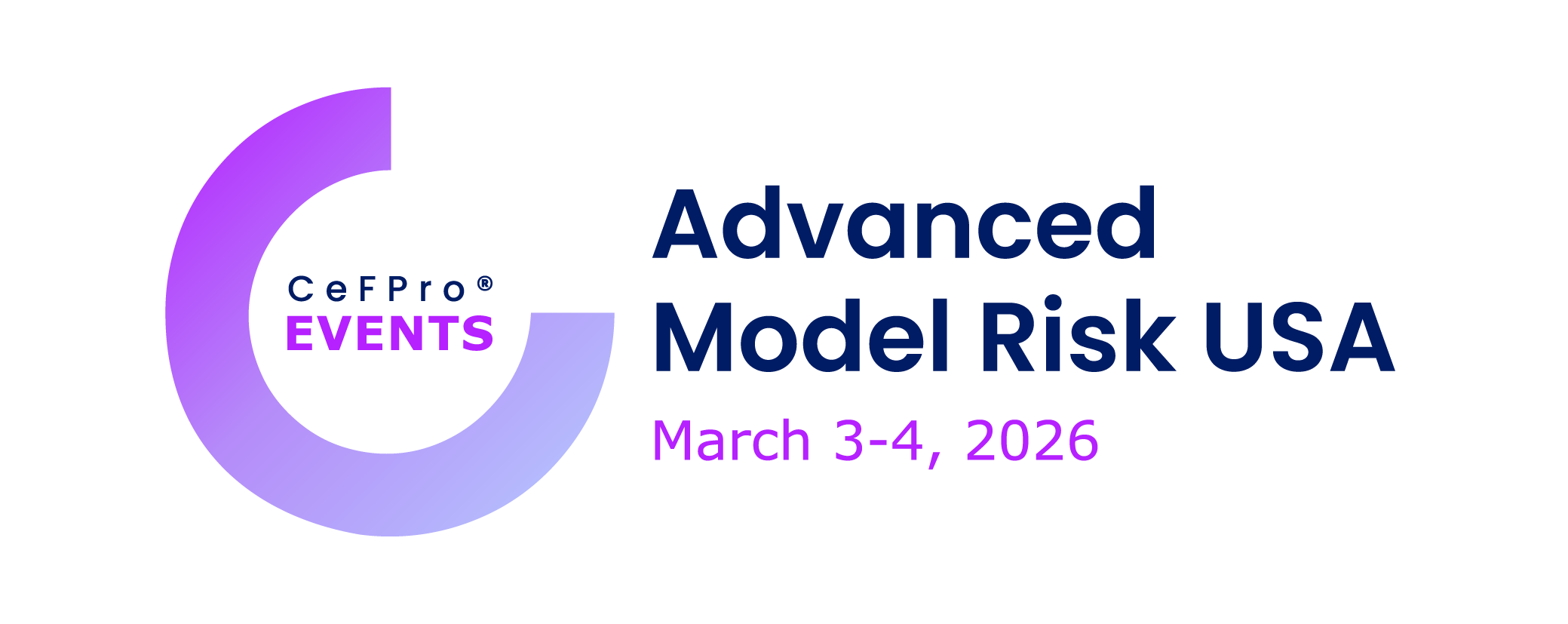Breakfast and networking
CHAIR’S OPENING REMARKS
THE EVOLVING ROLE OF THE CHIEF MODEL RISK OFFICER – KEYNOTE PANEL
What the next five years will look like for the CMRO
Strategic leadership at the intersection of regulation, innovation, and enterprise risk
- Balancing regulatory expectations with enterprise-wide strategic impact
- Communicating model risk to executive leadership and the board
- Preparing for thematic reviews, cross-border divergence, and AI-specific oversight
- Building high-performing teams and attracting scarce quant/AI talent
- Leveraging digital tools and RegTech to enhance model risk management
- Embedding model risk into broader risk, resilience, and business decision-making
REGULATORY LANDSCAPE AND ALIGNMENT
The regulators strike back: surviving evolving oversight
Navigating multi-regulator expectations across banking and financial services
- Interpreting SR 11-7, OCC guidance, PRA SS1/23, and EU AI Act in practice
- Mapping regulatory divergence across US, EU, and UK jurisdictions
- Preparing for thematic audits, horizontal reviews, and evolving expectations
- Responding to regulatory uncertainty around AI and emerging model classes
- Embedding agility to adjust governance to regime and administration changes
Morning refreshment break and networking
EVOLVING MODEL GOVERNANCE FRAMEWORKS – PANEL DISCUSSION
Frameworks built for today, ready for tomorrow
Reassessing model governance frameworks under expanding complexity and scrutiny
- Moving beyond tick-box compliance to value-add governance
- Building inventories that capture metadata, dependencies, and risk sensitivity
- Integrating AI and non-traditional tools into governance processes
- Ensuring scalability of growing model inventories
- Aligning governance between model risk and enterprise risk functions
VALIDATION APPROACHES FOR BLACK-BOX MACHINE LEARNING MODELS
Cracking open the black box
Future-proofing validation for next-generation AI models
- Why traditional validation frameworks fail when applied directly
- Model-agnostic techniques: stress testing, perturbation analysis, and sensitivity methods without transparency
- Governance and documentation standards: aligning SR 11-7, NYDFS 504, and supervisory expectations with opaque models
- Case study: fraud detection model — iterative testing, remediation, and lessons learned
- Forward-looking view: preparing institutions for next-gen AI models and evolving regulatory scrutiny
DEFINING A MODEL – PANEL DISCUSSION
One definition to govern them all Clarifying scope as new tools blur classification boundaries
- Differentiating between models, tools, AI systems, and automation
- Reviewing overlaps with RPA, dashboards, and copilots
- Incorporating GenAI tools (chatbots, copilots) into scope
- Addressing supervisory uncertainty on “non-model” governance
- Standardizing definitions of what constitutes a model across global institutions
Lunch break and networking
Luncheon roundtable Keep the conversation going and connect with your peers over engagingroundtable discussions with experts
| Organizational AI Literacy and Fluency Standards | MRM and AI Program Integrations/Enhancements |
VALIDATION OF GENERATIVE AND AGENTIC AI MODELS
Can you really validate what you don’t understand?
Adapting validation approaches for GenAI and emerging AI use cases
- Overcoming lack of transparency and explainability in large language models
- Developing outcome-based testing and stress scenarios for GenAI
- Building challenger approaches when models cannot be re-performed
- Addressing hallucinations, drift, and instability of AI outputs
- Managing resource gaps with human-in-the-loop and vendor tools
VALIDATION CAPACITY AND RESOURCE OPTIMIZATION
Smart resourcing for smarter models
Meeting rising demands with finite validation staff
- Prioritizing validations using risk-based approaches
- Leveraging challenger models and re-performance strategies
- Using automation and AI to support validation throughput
- Exploring sampling approaches without compromising assurance
- Outsourcing validation to external vendors and consultancies
BIAS, FAIRNESS, AND ETHICAL USE
With great power, comes great responsibility
Addressing fairness and reputational risks
- Managing bias and discrimination risks in facial recognition and biometrics
- Balancing predictive power of alternative data against fairness concerns
- Aligning with EU AI Act high-risk classifications and US fairness debates
- Preparing for regulatory reversal as administrations change stance on bias testing
- Navigating reputational exposures in customer facing AI deployments
Afternoon break and networking
FACIAL RECOGNITION & BIOMETRICS IN BANKING
When identity meets integrity
Testing and governing sensitive high-risk applications
- Evaluating demographic misidentification risks in biometric models
- Integrating fairness, inclusivity, and accessibility into model validation
- Governing customer onboarding, authentication, and employee ID verification
- Addressing reputational and regulatory challenges in biometric adoption
- Building secure and explainable biometric AI governance frameworks
TRANSPARENCY IN BLACKBOX MODELS - PANEL DISCUSSION
Shining light into the black box
Navigating blackbox models through disclosure and transparency
- Negotiating disclosure of training data, features, and assumptions
- Assessing models despite limited transparency into vendor IP
- Establishing validation expectations for black-box tools
- Leveraging independent testing where internal replication is impossible
- Balancing competitive advantage against risk management obligations
Chair’s closing remarks
End of day one and networking drinks reception
Breakfast and networking
CHAIR’S OPENING REMARKS
CROSS-FUNCTIONAL COLLABORATION – PANEL DISCUSSION
Breaking silos, building strength
Strengthening cross functional collaboration across model risk management
- Involving legal, privacy, cybersecurity, and compliance in model oversight
- Embedding MRM into product development and business innovation
- Building cross-functional risk committees for MRM governance
- Fostering transparent dialogue between developers and validators
- Building credibility and authority through strong communication with the C-suite
MEASURING AI AND GEN AI PERFORMANCE
When accuracy isn’t absolute – what’s next?
Developing new metrics for non-deterministic outputs
- Moving beyond traditional statistical measures
- Designing human-in-the-loop validation for GenAI outcomes
- Addressing instability and drift in AI model responses
- Exploring AI-to-AI validation and its circular challenges
- Sampling approaches to balance efficiency with reliability
Morning refreshment break and networking
VENDOR MODELS AND THIRD-PARTY DEPENDENCE
Outsourced doesn't mean out of mind
Managing risks of dependencies on vendor models
- Addressing lack of transparency in vendor AI and quant models
- Negotiating vendor accountability and explainability requirements
- Monitoring reliance on alternative data in third-party models
- Balancing vendor efficiency with internal control expectations
- Regulatory expectations for vendor model risk oversight
COUNTERPARTY CREDIT RISK MODELING
Balancing precision with practicality
Addressing methodological and data challenges in CCR modeling
- Capturing CVA exposures and mark-to-market impacts
- Building proxy models where liquid CDS data is unavailable
- Leveraging AI to model counterparty risk exposure under stress
- Balancing accuracy, stability, and data availability in calibration
- Aligning practices across larger and smaller banks with different maturity levels
DEPOSIT MODELING IN A HIGH-RATE ENVIRONMENT – Fireside Chat
Modeling the new reality of deposit behavior
Refining frameworks for deposit behavior and pass-through advanced modeling
- Assessing stickiness and sensitivity of customer deposits
- Modeling competitive dynamics and depositor switching
- Aligning deposit rate models with bank strategy and product incentives
- Capturing disintermediation between interest and non-interest-bearing accounts
- Stress testing deposit outflows under volatility and liquidity stress
Lunch break and networking
Luncheon roundtable Keep the conversation going and connect with your peers over engagingroundtable discussions with experts
| Model Validation Challenges | Model Inventory and Attestation Strategies |
EMERGING RISKS & GEOPOLITICAL SHOCKS
From trade wars to sanctions - modelling the fallout
Modeling emerging risks and geopolitical risks
- Modeling nonlinear and fast-evolving geopolitical shocks beyond traditional frameworks
- Stress testing macroeconomic models for stagflation, disrupted trade flows, and policy shifts
- Quantifying tariff, supply chain, and sanctions shocks across models
- Embedding geopolitical sensitivity into risk models under volatile conditions
- Capturing interdependencies across models to strengthen enterprise resilience
- Market, credit, and operational models
INOVATION IN MODEL INVENTORY TECHNOLOGY – FIRESIDE CHAT
Future proofing the backbone of model risk Advancing model inventory through leveraging technology and innovation
- Developing inventories with full metadata visibility across all variables
- Linking models to enterprise-level sensitivity analysis (e.g shocks to rates)
- Leveraging AI-driven model inventory management solutions
- Enhancing transparency, usability, and automation for regulators
- Future-proofing inventories to manage scale and complexity
Afternoon refreshment break and networking
TECHNOLOGY INNOVATION
Digital power meets model risk Leveraging digital transformation in model risk functions
- Using AI and automation to enhance validation efficiency
- Integrating big data into modeling frameworks and stress testing
- Streamlining data governance across model inventories
- Applying cloud and scalable tech to support large-scale risk engines
- Evaluating RegTech partnerships for supervisory alignment
DATA CONFIDENTIALITY
Data security is model security Ensuring confidentiality across models through detection, data traceability, and governance
- Blocking PII and customer data from being sent to public LLMs
- Deploying enterprise-wide detection and monitoring of sensitive prompts
- Establishing data retention, lineage, and traceability controls
- Embedding confidentiality and training-data restrictions in vendor contracts
- Aligning with cybersecurity and privacy teams to enforce shared safeguards
























